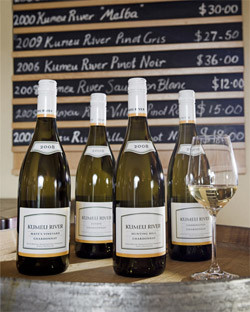So, my Wine of the Week is Pyramid Valley’s 2008 Earthsmoke Pinot Noir. It’s quite unlike anything I’ve tasted from New Zealand but then they’re doing things a little bit differently here.
The Burgundy-trained Californian, Mike Weersing, has been biodynamic since planting in this virgin territory in 2000. Before coming to New Zealand, he lived in a camper van “cadging†jobs off his heroes: Alsace’s Jean Michel Deiss, the Mosel’s Ernie Loosen and Burgundy’s Nicolas Potel. People thought he was mad leaving his winemaking job at Neudorf to set up in the unknown Pyramid Valley but he seems to have proven the sceptics wrong.
What is it that makes his wines so different to the rest of the country? Perhaps it’s the soil. Weersing said, “We could not locate the combination of clay and limestone anywhere else in Waipara.â€
Or could the explanation lie in low crops? The two-hectare vineyard planted with Pinot Noir and Chardonnay is planted at an Old World density of 1m by 0.8m with only 400g of fruit per vine. Elsewhere, it’s common to see 3.5kg of fruit on a vine – and 5kg for Sauvignon Blanc. The concentration comes through in the wines.
What’s more, 95% of his vines are ungrafted and he has found that those that are grafted on to American roostocks are the first to suffer drought. He’s also discovered that the roots of the ungrafted vines can penetrate the limestone whereas the grafted ones get to the limestone and stop burrowing down, missing out on all the mineral goodness of the limestone. While most would worry about the threat of phylloxera, this vineyard is pretty isolated and Weersing has little concern about the vine louse.
Weersing doesn’t irrigate either unlike many other New Zealand grape growers. In Marlborough, some producers on free-draining gravel soils have told me they irrigate twice a day with 400mm of water at the height of summer. But this goes against his idea of terroir. “You are not just expressing the soil, you are expressing the season,†he says, “ and if there’s a bit of drought stress then so be it. For example, if you love Chambolle Musigny Les Amoureuses, you want to see it in all its manifestations.â€
He makes his wines in a shipping container rather than a swanky winery. He doesn’t add anything including sulphur (until bottling) and when he does bottle his reds, he doesn’t fine nor filter, so expect a slightly cloudy wine but with all the good bits still in it. Considering his wines have a high pH (4.1 for his 08 Pinot Noir), this should mean that the wines are really unstable and prone to microbial spoilage. It goes against all the wine books that his wines should work. But they do.
Some people might think Weersing’s a hippy. Perhaps he is, but who cares? The wines are impressive and I’m slowly coming around to biodynamics. The proof is in the glass.


